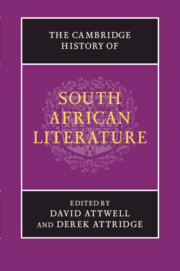Book contents
- Frontmatter
- Introduction
- PART I ORATURES, ORAL HISTORIES, ORIGINS
- 1 ‘The Bushmen's Letters’: |Xam narratives of the Bleek and Lloyd Collection and their afterlives
- 2 A contextual analysis of Xhosa iimbongi and their izibongo
- 3 ‘I sing of the woes of my travels’: the lifela of Lesotho
- 4 Praise, politics, performance: from Zulu izibongo to the Zionists
- 5 IsiNdebele, siSwati, Northern Sotho, Tshivenda and Xitsonga oral culture
- PART II EXPLORATION, EARLY MODERNITY AND ENLIGHTENMENT AT THE CAPE, 1488–1820
- PART III EMPIRE, RESISTANCE AND NATIONAL BEGINNINGS, 1820–1910
- PART IV MODERNISM AND TRANSNATIONAL CULTURE, 1910–1948
- PART V APARTHEID AND ITS AFTERMATH, 1948 TO THE PRESENT
- PART VI SOUTH AFRICAN LITERATURE: CONTINUITIES AND CONTRASTS
- Index
- References
5 - IsiNdebele, siSwati, Northern Sotho, Tshivenda and Xitsonga oral culture
from PART I - ORATURES, ORAL HISTORIES, ORIGINS
Published online by Cambridge University Press: 28 January 2012
- Frontmatter
- Introduction
- PART I ORATURES, ORAL HISTORIES, ORIGINS
- 1 ‘The Bushmen's Letters’: |Xam narratives of the Bleek and Lloyd Collection and their afterlives
- 2 A contextual analysis of Xhosa iimbongi and their izibongo
- 3 ‘I sing of the woes of my travels’: the lifela of Lesotho
- 4 Praise, politics, performance: from Zulu izibongo to the Zionists
- 5 IsiNdebele, siSwati, Northern Sotho, Tshivenda and Xitsonga oral culture
- PART II EXPLORATION, EARLY MODERNITY AND ENLIGHTENMENT AT THE CAPE, 1488–1820
- PART III EMPIRE, RESISTANCE AND NATIONAL BEGINNINGS, 1820–1910
- PART IV MODERNISM AND TRANSNATIONAL CULTURE, 1910–1948
- PART V APARTHEID AND ITS AFTERMATH, 1948 TO THE PRESENT
- PART VI SOUTH AFRICAN LITERATURE: CONTINUITIES AND CONTRASTS
- Index
- References
Summary
Traditional contexts
While the oral cultures in southern Africa may share the same oral genres and performance strategies, different contexts provide for peculiarities. A few of these contexts will be mentioned before elaborating on aspects of Ndebele verbal art as an illustration of the range and evolution of oral discourse in South Africa.
In her study on Hananwa and Lobedu oral performance, Annekie Joubert gives an idea of the vibrancy of their song culture in particular:
Almost every phase and event in the yearly cycle of the Hananwa and Lobedu are accompanied and embraced with song. Men sing as they manufacture various crafts, execute strenuous physical work, relax around the fire in the evenings, at beer-drinking gatherings, or over weekends when they perform the drum-flute ensembles. The women sing as they perform household tasks, when they gather to assist one another to perform communal tasks, in the relaxing hours of the evening, during periods of drought and subsequently when the rain has fallen, at church gatherings and at festivities.
(Power of Performance, p. 267)The annual rainmaking ceremony performed by the people of ‘the rain queen’ Modjadji of the Lobedu showcases the most important ceremony. Joubert's study, however, gives a view of the daily struggles and pastimes of men, but especially those of women. Secluded on the plateau of the Blouberg, a mountain in the north-west of the country, Lobedu women sing about their cares as they are left behind by their migrant husbands.
- Type
- Chapter
- Information
- The Cambridge History of South African Literature , pp. 95 - 112Publisher: Cambridge University PressPrint publication year: 2012
References
- 1
- Cited by

